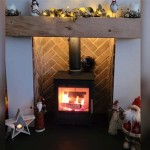How To Install A Floating Mantel On Stone Fireplace Surrounds
Installing a floating mantel above a stone fireplace surround can dramatically enhance the aesthetic appeal of a living space. The combination of the natural texture of stone with the clean, modern lines of a floating mantel creates a focal point that is both rustic and contemporary. However, the process requires careful planning, precise execution, and a solid understanding of the materials and techniques involved. This article will provide a comprehensive guide to installing a floating mantel on a stone fireplace surround, ensuring a secure and visually appealing result.
Before embarking on the project, it is crucial to consider several factors. The weight of the mantel, the type of stone used in the fireplace surround, and the structural integrity of the wall behind the stone are all critical determinants of the installation method and the necessary hardware. Ignoring these factors can lead to a compromised installation, resulting in a sagging or even detached mantel. Therefore, thorough preparation is paramount to a successful outcome.
Choosing the right mantel material is also important. Common choices include solid wood, engineered wood, and even concrete. Solid wood mantels offer a classic, natural look and can be stained or painted to match the room's décor. Engineered wood provides a cost-effective alternative with enhanced stability and resistance to warping. Concrete mantels offer a modern, industrial aesthetic and can be custom-made to specific dimensions and finishes. The selection should be based on personal preference, budget, and the overall design of the room.
The tools and materials required for this project are relatively standard but must be of high quality to ensure a secure and lasting installation. A drill with various drill bits (including masonry bits), a level, a stud finder, a measuring tape, construction adhesive, shims, and appropriate mounting hardware (such as heavy-duty brackets or rods) are essential. Safety glasses and dust masks are also necessary to protect against debris and dust generated during drilling and cutting.
Key Point 1: Planning and Preparation
The initial phase of the installation process involves meticulous planning and preparation. This stage includes determining the desired height of the mantel, assessing the stone fireplace surround, and selecting the appropriate mounting method. Accurate measurements and a clear understanding of the structural requirements are essential for a successful installation.
Determining the optimal height for the mantel is a matter of personal preference and room aesthetics. However, building codes often dictate minimum clearances between the top of the fireplace opening and combustible materials like wood mantels. Consulting local building codes is crucial to ensure compliance and prevent fire hazards. Generally, a distance of at least 12 inches is recommended for gas fireplaces, and 18 inches or more for wood-burning fireplaces.
Next, a careful assessment of the stone fireplace surround is necessary. Identify the type of stone used, its thickness, and its method of attachment to the wall. Natural stone can vary significantly in density and porosity, which can affect its ability to withstand drilling and anchoring. If the stone is thin or loosely attached, it may require additional support or reinforcement before installing the mantel. In some cases, it may be necessary to consult with a professional stonemason to assess the structural integrity of the surround.
Choosing the appropriate mounting method is crucial for a secure and stable floating mantel. Several options are available, each with its own advantages and disadvantages. Heavy-duty brackets, hidden steel rods, and specialized floating mantel hardware are common choices. The weight of the mantel, the type of stone, and the desired aesthetic will influence the selection. Brackets provide a straightforward and reliable method for supporting heavier mantels, while hidden rods offer a cleaner, more minimalist look. Specialized hardware is designed specifically for floating mantels and often includes adjustable features for precise alignment.
Another crucial step in the planning process is locating the wall studs behind the stone fireplace surround. While the stone provides a decorative finish, the underlying wall studs offer a solid anchor point for the mantel supports. A stud finder can be used to locate the studs, and their position should be carefully marked on the wall. If the studs are not aligned with the desired mantel location, additional blocking may be required to provide adequate support. Blocking involves adding horizontal pieces of wood between the studs to create a secure surface for attaching the mantel supports.
Key Point 2: Installation Techniques
The installation phase involves drilling into the stone fireplace surround, attaching the mounting hardware, and securing the mantel in place. This stage requires precision, patience, and the use of appropriate tools and techniques to avoid damaging the stone or compromising the structural integrity of the installation.
Drilling into stone requires special care to prevent cracking or chipping. A hammer drill with a masonry bit is essential. Start by marking the desired location for the mounting holes using a pencil or marker. Use a center punch to create a small indentation at each mark, which will help guide the drill bit and prevent it from wandering. Begin drilling slowly and apply consistent pressure. Avoid using excessive force, which can cause the stone to fracture. Gradually increase the drilling speed as the bit penetrates deeper into the stone.
Once the holes have been drilled, insert the appropriate anchors. The type of anchor will depend on the type of stone and the weight of the mantel. Expansion bolts, sleeve anchors, and chemical anchors are all suitable options. Expansion bolts provide a strong and reliable hold in solid stone. Sleeve anchors are ideal for anchoring into hollow stone or brick. Chemical anchors involve injecting a resin into the hole, which bonds with the stone and the anchor for maximum holding power. Follow the manufacturer's instructions carefully when installing the anchors.
With the anchors in place, attach the mounting hardware to the wall. Whether using brackets, rods, or specialized hardware, ensure that the supports are securely fastened to the anchors. Use a level to ensure that the supports are perfectly horizontal. Misaligned supports can result in a tilted mantel, which can detract from the overall aesthetic and potentially compromise its stability. Tighten all screws and bolts securely, but avoid over-tightening, which can damage the anchors or the stone.
Finally, carefully slide the mantel onto the mounting hardware. If using brackets, ensure that the mantel is fully seated on the brackets and that the weight is evenly distributed. If using rods, gently slide the mantel onto the rods, ensuring that they are fully inserted into the pre-drilled holes in the mantel. Use shims to make minor adjustments to the mantel's position and ensure that it is perfectly level. Once the mantel is in place, secure it to the mounting hardware using screws or adhesive, depending on the type of hardware used.
Key Point 3: Finishing and Fine-Tuning
The final phase of the installation process involves concealing the mounting hardware, addressing any imperfections, and applying a protective finish to the mantel. This stage elevates the overall aesthetic and ensures a seamless, professional-looking result.
Concealing the mounting hardware is essential for achieving a clean, floating look. If using brackets, the brackets can be hidden by recessing them into the back of the mantel or by covering them with decorative caps. If using rods, the holes where the rods enter the mantel can be filled with wood filler or color-matched caulk to create a seamless finish. The goal is to make the mounting hardware as invisible as possible, allowing the mantel to appear to float effortlessly above the fireplace surround.
Addressing any imperfections is crucial for a polished final product. Inspect the mantel for any scratches, dents, or blemishes. These can be repaired using wood filler, stain, or paint. Pay particular attention to the edges of the mantel, which are often prone to damage during installation. Use sandpaper to smooth any rough edges and apply a touch-up finish to blend them seamlessly with the rest of the mantel. Any gaps between the mantel and the stone fireplace surround can be filled with caulk or sealant to create a clean, professional look.
Applying a protective finish to the mantel is essential for preserving its beauty and extending its lifespan. The type of finish will depend on the material of the mantel and the desired aesthetic. Polyurethane provides a durable, water-resistant finish that is ideal for wood mantels. Oil-based finishes enhance the natural grain of the wood and provide a warm, rich tone. Paint offers a versatile option for matching the mantel to the room's décor. Consider the environment in which the mantel will be installed. If the fireplace is frequently used, choose a heat-resistant finish that can withstand high temperatures. Apply the finish according to the manufacturer's instructions, using multiple thin coats for optimal protection and durability.
Finally, inspect the installed mantel to ensure that it is securely attached, level, and aesthetically pleasing. Gently apply pressure to the mantel to test its stability. If it wobbles or flexes excessively, re-evaluate the mounting hardware and make any necessary adjustments. Use a level to double-check that the mantel is perfectly horizontal. If there are any minor discrepancies, use shims to make fine-tuning adjustments. Step back and admire your work. A well-installed floating mantel can transform the look and feel of a living space, creating a warm, inviting, and stylish focal point.

Installing And Making A Floating Mantle For Our Stone Fireplace

How To Build And Hang A Mantel On Stone Fireplace Shanty 2 Chic

How To Build And Hang A Mantel On Stone Fireplace Shanty 2 Chic

How To Install A Floating Mantle The Easy Way In Just One Afternoon

How To Hang A Wood Mantel On Stone Fireplace Using Rebar Before After

Fireplace Mantel Installation Before And After

Fireplace Mantel Installation Before And After

Installing And Making A Floating Mantle For Our Stone Fireplace

Wood How To Build A Mantel On Rough Stone Fireplace Home Improvement Stack Exchange
Fireplace Mantel Installation Before And After
Related Posts








